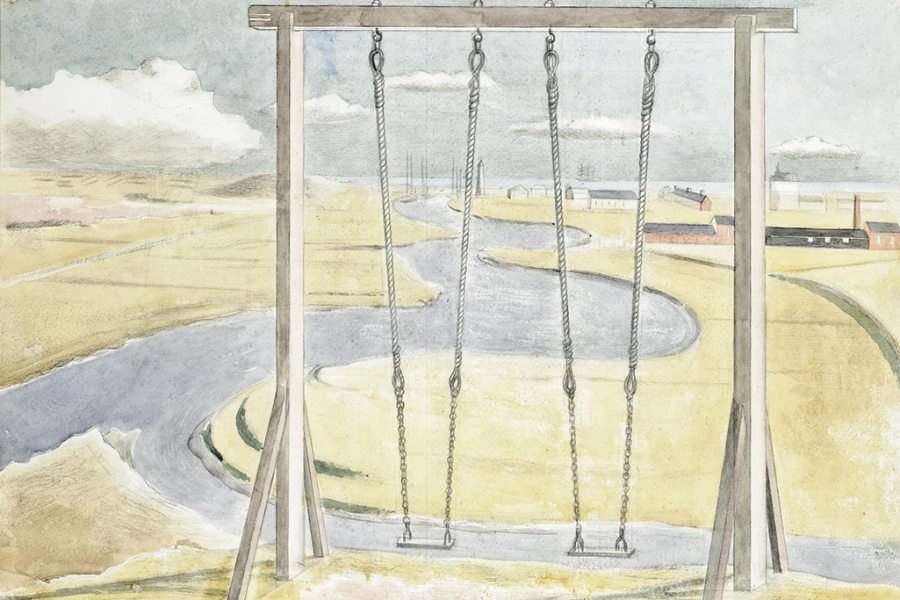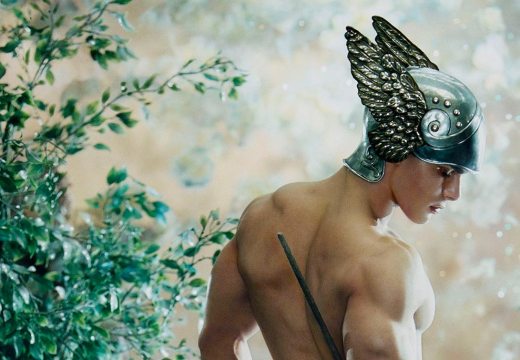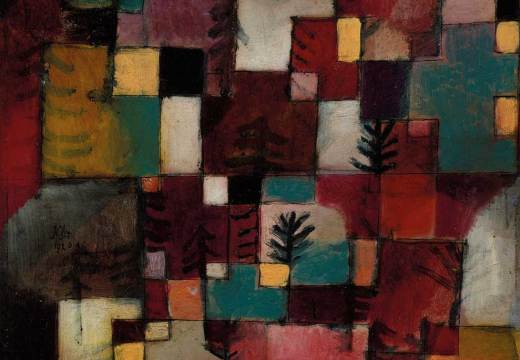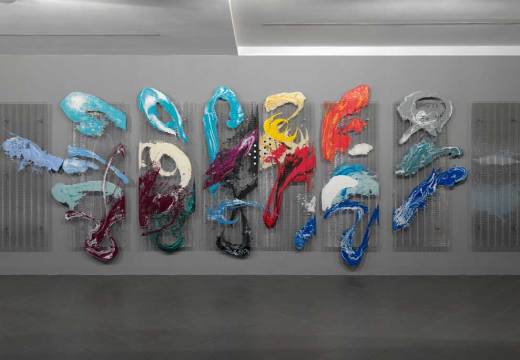Among my highlights from this year’s London Art Fair is River (1932), a modest but captivating work on paper by Paul Nash (Piano Nobile). Behind two empty children’s swings, a broad grey river potters down to the sea through a wide green floodplain. In the distance, clusters of agricultural or perhaps industrial buildings, a lighthouse, rigging. And further off, the narrow strap of the horizon.
We are not far away from a naturalistic landscape here. But the foreground denies the eye any chance to settle. The taut verticals of the swings’ ropes and chains cut through the landscape, as do the upright struts of the structure that holds them – a wooden scaffold that might just as well double as maritime gallows. The whole assembly is a picture frame that has been internalized into the image. But it’s not one that helps to define and demarcate the composition; rather, it disrupts distances, confounds planes and perspectives. Look again, and the seats of the swings are barges making their slow way to the mouth of the river.
This structure is not a building, of course, but to me it seems a surrogate for one. It is a very human construction in the landscape, one poised like a question mark that determines the intonation of the world beyond it. And so, in a sense, this is an exemplary scene. For broadly speaking – and it is a broad claim – architecture, infrastructure, things built in the landscape of modern British painting have a way not of ordering a composition or careful view, but of querying how we look on and relate to it. Even where picturesque principles are revisited, as in works by Piper or Ravilious, the sense of aftermath is usually palpable.
This Saturday afternoon Apollo hosts a panel discussion at the London Art Fair on ‘Building and the Landscape in Modern British Painting’. It promises to be a fascinating hour, in which we’ll explore how architecture old and new affected the representation of landscape – and indeed the idea of it – in 20th-century British painting.
Simon Martin, Artistic Director of Pallant House Gallery, will discuss the contrast between nostalgic and industrial visions of the landscape, focusing on works by Prunella Clough, John Tunnard and Edward Burra – and their power stations, radar installations and motorways.
James Purdon, Fellow of Jesus College, Cambridge, will explore how infrastructure – pylons, lighthouses and and other technological-architectural forms – allowed painters to imagine new kinds of social relation through representational choices in the ’20s and ’30s, particularly in the work of Romantic Surrealists such as Nash and Tristram Hillier, as well as artists associated English Constructivism.
And Maggie Gray, Web Editor of Apollo, will explain how Peter Lanyon’s imaginative descents into Cornish tin mines stemmed from aesthetic disagreements with his fellow St Ives artists. The painter found a deep independence in the infrastructural heritage of Cornwall.
Please do join us, from 2.45–3.45 at the Business Design Centre, Islington, London on Saturday 18 January. Further information about the fair and event can be found here.
Unlimited access from just $16 every 3 months
Subscribe to get unlimited and exclusive access to the top art stories, interviews and exhibition reviews.














![Masterpiece [Re]discovery 2022. Photo: Ben Fisher Photography, courtesy of Masterpiece London](http://www.apollo-magazine.com/wp-content/uploads/2022/07/MPL2022_4263.jpg)
Why are fathers so absent from art history?